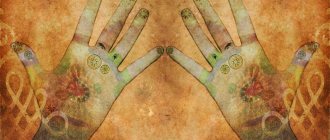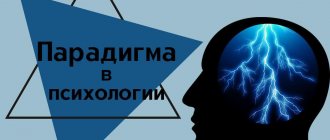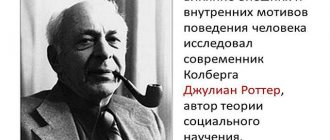What is psychoanalysis: the essence of the theory
Let's define the concept. The name is derived from two Greek words: “soul” and “decomposition, dismemberment.” The concept entered the scientific community in 1896 after the publication of a German article on the origin of neuroses. It is no longer possible to say exactly who first introduced the concept of psychoanalysis, but Sigmund Freud is considered its founder. It was he who invented psychoanalysis and proposed it as a branch of psychology.
The Laplanche and Pontalis dictionary gives the following definition of psychoanalysis: “This is a research method based on identifying the unconscious meanings of words, actions, products of human imagination (dreams, fantasies, delusions); a method for treating neurotic disorders based on this research; a set of theories of psychology and psychopathology that systematizes data obtained by the psychoanalytic method of research and treatment.”
Thus, psychoanalysis in simple words is a scientific theory and method of treating mental disorders. It is currently being considered in three areas:
- as a psychological and philosophical theory of personality;
- as a set of principles and methods for studying the unconscious of the individual;
- as a direction in psychotherapy that helps get rid of intrapersonal conflicts, neuroses, complexes, psychoses, depression, phobias and other problems.
Psychoanalysis in psychology is considered both theory and practice. Let's look at the essence of S. Freud's theory of psychoanalysis.
What does psychoanalysis study? Unconscious motives and desires of the individual. If we talk about psychoanalysis as a theory, then its essence can be reflected in several theses (features):
- the conflict between the conscious and unconscious leads to the development of neuroses, fears, depression and other psychological problems;
- thoughts and behavior are determined by unconscious desires;
- awareness of true motives, needs, desires is difficult due to the inclusion of protective mechanisms of the psyche;
- psychological problems can be solved if they are brought to the level of consciousness (this can be done using psychoanalytic methods).
The basic idea of Freud's psychoanalysis is that there can be no inconsistency or interruption in human mental nature. That is, everything that a person has in the present is the result of the past. If something doesn’t suit you now, then you need to look for the reason in the past. And now we will analyze everything in more detail and in order.
Lacanian books on psychoanalysis
Jacques Lacan was a French Freudian psychoanalyst . He is famous for the theories that followed in Freud's footsteps, but his books are quite difficult to understand at first. It may even seem incomprehensible or meaningless.
But you must understand the logic of his ideas when you allow him to briefly reflect in your head. After a while everything will become more clear. If you read his books carefully, you are sure to find some amazing ideas.
Seminars. Book 3. Psychoses (1955-1956)
This is a fascinating book. Lacan develops his theory of psychosis. His ideas are revolutionary and innovative. What we mean is that it gives a different idea of our usual idea of psychosis. This goes from what causes psychosis, all the way to how we feel about it.
He is also studying Memoirs of My Nervous Illness, the autobiography of Daniel Paul Schreber. He was president of the German appeals court and then developed paranoid schizophrenia. This book was of great interest to Freud, and Lacan developed a complete theoretical understanding of it. This is an absolutely fascinating look at the Schreber case.
Who is the founder of psychoanalysis
The author of the theory and founder of the method of psychoanalysis is the Austrian psychologist, psychoanalyst, psychiatrist and neurologist Sigmund Freud. He was also the founder of the school of psychoanalysis. Sometimes the theoretical basis of psychoanalysis (Freud's philosophy) is called Freudianism. Freud's theory had a significant influence on psychology, medicine, sociology, anthropology, literature and art of the 20th century.
Interesting! Freud's closest followers were K. Jung, K. Horney, A. Adler, E. Fromm and others. Some of the modern psychologists also rely on Freud's teachings.
Analytical Psychology, 1912
Another direction that got its start at the beginning of the 20th century. and who had interest in the professional environment is the analytical psychology of the psychiatrist and teacher from Switzerland Carl Gustav Jung. In his works, C. Jung decomposes the personality structure into layers: persona, ego, shadow, Anima in men and Animus in women, self.
A person’s goal, which determines life’s meaning and basic need, according to the theory of C. Jung, is aimed at achieving selfhood by passing through conscious layers (persona, ego) and unconscious (the collective unconscious follows the individual). The topmost layer of the unconscious is the shadow, i.e. the double of “I”, the lowest – the self, i.e. real "I". It is C. Jung who owns the division of the unconscious into individual and collective. Thus, the semantic core of analytical psychology is the issue of individuation, that is, a person’s finding the self as a unique integrity, since each individual initially has a vector for self-development.
Basics of psychoanalysis
The unconscious, sexual instinct, sublimation, Freudian slip - you may have heard these concepts. All of them relate to psychoanalysis. Do you know their definitions and essence? Now let’s figure it all out, consider the basics of personality psychoanalysis, and analyze the key concepts.
Consciousness and unconsciousness
In the theory of psychoanalysis, Freud identified 2 structures of the psyche. Each of them has three layers, but these structures are somewhat different from each other. First, let's look at the layers of the first structure:
- Unconscious. All secret desires, repressed memories, animal instincts, immoral desires are stored here.
- Preconscious, or subconscious. At this level is located what a person knows and remembers at the present time or, if desired, can remember.
- Consciousness. These are thoughts, feelings, emotions, plans of a person in the present.
This is the primary structure of the psyche according to Freud. Later, the psychoanalyst discovered the method of free associations and developed a new structure (concept) of the structure of the psyche. In it he identified three elements: It, I and Super-ego.
"It", "I" and "Super-ego"
According to the theory of psychoanalysis, our psyche has three levels:
- Id (It), or lower level. This is the level of instincts, drives - everything that remains in us from animals. This is also the level at which all repressed desires, memories, and needs are stored. Simply put, this is the level of the unconscious (popularly it is often called the subconscious, but now you know the difference). What happens at this level is beyond our control. It reminds itself of itself through emotions and feelings, mental states, dreams, slips of the tongue and typos, bodily symptoms, etc.
- Ego (I), or middle level. This is the field of our awareness. Experience, knowledge, skills, beliefs and everything that we have accumulated in the process of socialization have gathered here. We control and understand everything that is here, we can control our thoughts and behavior.
- Super-Ego (Super-I), or highest level. This is our inner moralist, critic and censor - conscience, if you like. At this level all our ideas about “what is good and what is bad” and how we should behave in society are located.
Often the id and the superego come into conflict, and the ego tries to reconcile them. In fact, every person spends most of his life in such a search for a balance between animal instincts and the highest moral values, prohibitions, and norms. Not everyone manages to maintain balance; sometimes we are tossed in one direction (we give in to desires, emotions), then in the other (we rationalize life too much, block our feelings and suppress desires). Both are dangerous. If falling to one side occurs too often, a person develops complexes, neuroses and other psychological problems.
Important! Suppressed desires lead to the development of complexes. Sublimation helps get rid of frustration (experience due to the inability to satisfy a need).
Defense Mechanisms
According to Freud, any psychological problems are associated with the conflict between the animal and the social in man. That is, when a person suppresses desires that are shameful by social standards, he gets sick, becomes aggressive, apathetic, and irritable. This can be avoided if you redirect the animal impulse into a productive direction: creativity, sports, career building, social activity. This is called sublimation - the transfer of sexual energy to another activity. Sublimation is one of the protective mechanisms of the psyche named by Freud.
In addition to sublimation, the psychoanalyst identified 7 more defense mechanisms (later other psychologists expanded this classification):
- Crowding out. If a person does not understand how to satisfy his desires in a socially acceptable way, but cannot forget about it, then he represses them to the level of the unconscious. And he seems to forget (he really doesn’t remember). However, this does not mean that the impulses have disappeared. They continue to influence a person's thoughts and behavior. A lot of energy is spent on restraining desires, which is why a person soon falls ill.
- Negation. The person convinces himself that it seemed to him that it happened by accident, that he misheard, etc. In general, he tries his best to convince himself that something unpleasant did not happen or that it did not happen to him.
- Rationalization. A person convinces himself that he could not have acted differently. Yes, he committed a shameful act, but it was necessary. In most cases, the explanation actually looks logical, but it has nothing to do with the true motives.
- Projection. A person blames others for what he does not accept in himself. For example, a cheater accuses his partner of cheating, a traitor suspects his friend, etc.
- Substitution. When a person cannot take out his anger on one object, he takes out his aggression on another. For example, a child who is beaten by his parents beats younger children and abuses animals. A man who cannot hit his boss takes it out on his children and wife at home. By the way, replacement concerns not only aggression. Any emotion and feeling can take part in this. For example, a young man likes one girl, but he cannot be with her, so he meets with a more accessible one, imagining that passion (and sometimes trying to make the second girl the first).
- Inversion. This is an attempt to evoke exactly the opposite feelings towards an object. For example, in order to survive a painful breakup, a girl begins to concentrate on the man’s real and imagined shortcomings. The goal is to make the object disgusting, not so attractive. Then the desire and attraction to him will disappear.
- Regression. This is a return to the previous stage of development, that is, the inclusion of children's behavior patterns. You may have thought that we are talking about hysterics, screaming, crying, insults, demonstrative care, etc. Yes, but not only. Alcoholism, gambling, drug addiction, eating problems, smoking - this is also a form of regression. Adults do not escape reality - they solve problems.
The protective mechanism of the psyche is a set of unconscious reactions that protect a person from negative emotions and experiences. Defense mechanisms help maintain mental balance. However, you cannot rely only on these forces all the time. Frequent use of defense mechanisms leads to personality deformation and hinders socialization. And also, defense mechanisms sometimes fail, which also does not benefit the individual.
Psychosexual development
According to Freud, every person goes through 5 stages of psychosexual development, each of which has its own leading need:
- Oral (0 – 1.5 years). At this stage, the baby needs close communication with the mother through breastfeeding. The mouth area is associated for a child with safety, care, and tenderness.
- Anal (1.5 – 3 years). The need for independence prevails. This is potty training period. Going to the toilet independently is a child’s first conscious and serious action. He likes to feel that he is in control of himself and the situation. At the anal stage, the rudiments of self-control and self-regulation are formed.
- Phallic (3 – 6 years). This is the stage of passing through the Oedipus complex (for girls - the Electra complex). According to Freud's theory, sexual energy is inherent in a person from birth. At the age of 3-6, children develop an interest in the parent of the opposite sex. The child tries with all his might to get his attention, love, care. Aggression and jealousy awaken towards a parent of the same sex as the child. Gradually, the offspring realizes that he is losing the “war”; the attraction goes to the subconscious level. In the future, it will transform into a search for a partner who is similar to a parent.
- Latent (6 – 12 years). At this stage, the libido is dormant. The child needs social activity. It is important to encourage meeting with friends, participating in hobby groups, etc. Freud called reorientation toward social activity sublimation. And it is at this stage, as Freud believed, that the Ego and Superego appear.
- Genital (puberty and up to 22 years). Sexual energy awakens, now it is directed towards the teenager’s peers. At first, interest in people of the same sex arises (this takes the form of friendship), and later the young man’s attention switches to people of the opposite sex. In adulthood, this results in the building of love relationships and family.
For example, getting stuck at the anal stage of development leads to the formation of an anal character. Such a person is characterized by stinginess, greed, stubbornness, pedantry, a tendency to aggression and self-destruction, impulsiveness, and conflict.
Note! Getting stuck at stages of development occurs due to insufficient or excessive satisfaction of the leading needs of this period. That is, the child was either not given something and for the rest of his life he tries to get what he wants, to compensate for the previous deficit, or he was “strangled” with something and in adult life he defends himself with all his might, defends personal boundaries, avoids what reminds him of the problem period from childhood.
Complexes
The concept of “complex” appeared in later versions of the theory of psychoanalysis and is associated with the name of Freud’s follower – A. Adler. A complex is a set of experiences that arise against the background of a contradiction between personal and social, “I want” and “should.”
They often talk about an inferiority complex - this is a combination of a person’s experiences due to the subjective perception of his own failure. Simply put, a person considers himself worse than others, less worthy. He sees the happiness and success of those around him, wants to feel the same, but cannot and does not know how to achieve this.
In fact, human psychoanalysis examines much more complexes. Here are just a few of the popular ones:
- overcompensation complex - attempts to hide an inferiority complex through a demonstration of strength and aggression;
- Phaedra complex - painful overprotection of a mother in relation to her son;
- Polycrates complex – fear due to rapid development in life, anxiety against the backdrop of success;
- Jonah complex – self-doubt and a feeling of unworthiness, denial of personal achievements and victories;
- excellent student complex - a craving for perfectionism, the desire to be a “good girl” or “good boy” in everything;
- impostor complex - a person thinks that he is taking someone else’s place, that he accidentally received all the benefits that he has.
Methods of psychoanalysis
As we have already found out, psychoanalysis is not only a theory, but also a practice. With its help, you can diagnose and correct your mental state. Psychoanalysis includes many techniques for working with the unconscious, but all of them can be divided into three groups.
Methods of psychoanalysis:
- Interpretation. The point is to analyze and comprehend minor elements: slips of the tongue, random phrases, errors in speech, etc. The psychoanalyst and the client talk about the person’s past, present and visible future, and during this the specialist identifies hidden problems and fears. That is, he interprets the client’s words and helps to “translate” them. Interpretation does not act as an independent method, but as an auxiliary one. For example, it is used in combination with two other popular methods of psychoanalysis: the method of free association and the method of dream interpretation.
- Free associations. The psychoanalyst calls the client words, phrases or shows pictures and invites him to respond with the first thing that comes to mind. Auxiliary materials are prepared in advance. They can be developed by the psychologist himself for a specific case. Or the specialist uses well-known techniques, for example, the Rorschach drawing test (ink spots on paper). It was Freud, with his psychoanalysis and the method of free association, who created the image of a patient lying on a couch and a psychologist listening to the client. In life, such communication is rare, but then Freud interacted with clients this way. He invited the person to lie down on the couch, relax and start saying whatever came to mind. Strange, obscene, fantastic, shameful - it doesn’t matter. There are no taboos in the psychoanalyst’s office, and the specialist adheres to the principle of a non-judgmental attitude. Sooner or later, in the process of such a free flight of associations, a person independently came to the main conflict.
- Analysis of dreams. Nowhere does the unconscious manifest itself more actively than in dreams. Particular attention should be paid to recurring dreams or dreams after which a person wakes up “broken.” According to Freud, the stranger the dream, the more meaning it makes. The fact is that in dreams any prohibitions and censorship disappear, defense mechanisms are turned off, everything that has accumulated there comes out of the unconscious. However, not all so simple. True experiences, desires, needs in dreams are shown by symbols. And these are the symbols that the consciousness of a particular person will accept. That is, a certain “filter” is preserved even in the realm of the unconscious – sleep. To immerse yourself in the art of reading dreams, study S. Freud's book “The Interpretation of Dreams.”
Using these methods, you can look into a person’s unconscious, identify repressed desires, emotions and memories, understand the motives of actions and correct behavior.
Important! Do not confuse psychoanalysis with psychotherapy. The psychoanalyst is largely responsible for ensuring that the person speaks freely and finds the origins of the problems themselves, as well as their solution. The psychoanalyst guides, but does not give direct instructions and advice.
Concept
We have already said a lot about Freud’s theory, but all of this is somehow generalized, mixed up (new and old). What is the concept of Freud's original theory of psychoanalysis? Let us outline the main provisions (features) of psychoanalysis:
- All psychological problems of the individual are caused by the conflict between the conscious and unconscious.
- Physiological needs suppress the needs of higher levels. As Freud said, “at the basis of all our actions are the desire to become great and the sexual desire.”
- Every incident in a person's life has its consequences.
- Every action has an obvious or hidden motive, which is associated with a person’s previous experience.
- The individual development of a subject is determined by the structure of the personality, childhood and youth experience.
- The psyche is a complex mechanism consisting of three levels: It, I, Super-ego. It is important to study all this in a comprehensive manner and look for the causes of psychological problems in the present at the level of the It (unconscious).
In the theory of psychoanalysis, the subject of study is unconscious motives leading to mental disorders.
Now let's move on to an analysis of the types of psychoanalysis.
Three Essays on the Theory of Sexuality (1905)
This book, along with the previous one, is one of Freud's most important works. Here Freud talks about his theory of human sexuality, which is focused primarily on childhood. In this book you will find his famous controversial statement: " Children can become polymorphously perverted ."
With this book, Freud wanted to explain his idea that perversion exists even in healthy people. He said that the path to mature and normal sexual attitudes actually begins in childhood, not puberty.
He delved into human psychosexual development, talking about such things as penis envy, castration anxiety and the Oedipus complex. Thus, it is a must read if you want to understand the evolution of psychoanalysis.
What directions (types) of psychoanalysis exist today?
In modern theories of psychoanalysis, the emphasis has shifted from sexuality. Psychologists consider not only this need as the cause of all troubles, but also other unmet needs.
For example, people with a heightened and unsatisfied need for power often become tyrants at home or at work. People who lack warm social contact surround themselves with animals. People who cannot or are afraid to have children, but want it, also direct their energy towards animals, for example, cats. Women who cannot succeed as professionals find themselves in raising children.
Classical Freudian psychoanalysis is one of the types of this teaching known to psychology. There are other schools (directions) of psychoanalysis. Let's briefly highlight them:
- Ego psychology. If Freud paid more attention to the Id, then here all attention is focused on the Ego (I), that is, the conscious part of the personality.
- Object Relations Theory. This theory is based on the proposition that the psyche is a system of internal objects that are a reflection of people and situations from the outside world. The specifics of relationships with people in the present and the life scenario are determined by the childhood experience of the subject. That is, in adulthood a person reproduces what he was used to in childhood.
- M. Klein School. The psychoanalyst paid more attention to child psychoanalysis, in particular to the analysis of the Oedipus complex. She considered love and aggression as the main driving forces of the psyche. The first one heals, the second one splits the psyche.
- Structural psychoanalysis by J. Lacan. The psychoanalyst viewed a person strictly as a subject and proposed solving psychological problems through speech. He considered the basis of personality to be a tandem of three elements: imaginary (a person’s idea of himself based on knowledge of other people), symbolic (search for differences in himself and others), real (situation, place where the individual first met another). The psychoanalyst depicted this as a symbol of three connected rings. If even one ring is opened, the mental balance of the individual will be disrupted.
- Interpersonal psychoanalysis (G.S. Sullivan, Clara Thompson). Attention is focused not on the analysis of personality, but on the analysis of interpersonal relationships. It was this element that psychoanalysts considered the most important and significant in the mental development of the subject.
There are other modern areas of psychoanalysis, but these are the most in demand.
On the baby's side
This is the French writer Francoise Dolto. Even though it is on the list of books on psychoanalysis, it is quite easy to read. This children's book on psychoanalysis goes beyond the boundaries by reversing the order: it sees the world from children's perspective and focuses on what children want.
Françoise Dolto doesn't just talk about listening to and understanding children in their native language. She also says that it is important to speak to them in our own language without pressuring them. This is a valuable and clear book that will not disappoint.
How psychoanalysis influenced the development of psychology
Freud's theory of psychoanalysis contributed to the development of psychology. Psychoanalysis made a real revolution in the world of psychotherapy and psychiatry. This theory was reflected in the works of other psychologists (representatives of psychoanalysis): A. Freud, D. Winnicott, H. Hartmann, M. Mahler, E. Glover, E. Erikson, M. Klein and others. Direct followers of Freud are Carl Jung, Alfred Adler, Otto Rank, H. Hartman, E. Chris, Anna Freud (daughter of the famous psychoanalyst).
What is the significance of psychoanalysis for fundamental and practical psychology? After Freud's discoveries, researchers began to pay more attention to the topic of defense mechanisms of the psyche, stages of mental development of the individual, levels of consciousness, and psychosomatic disorders. Dreams received special attention. Before the publication of the book “The Interpretation of Dreams” by S. Freud, they were not given such importance.
Interesting! Freud's teachings even influenced cinema. Alfred Hitchcock, Federico Fellini, Michelangelo Antonioni, Paolo Pasolini were inspired by his works.
Humanistic direction, 1951
In the 60s of the XX century. Humanistic approaches in psychology, centered on the uniqueness of the individual, are actively developing. One of the representatives and leaders of the humanistic movement is the American psychologist Carl Ransom Rogers. In his opinion, the “self-concept” acts as the foundation of the personality structure and is formed as a result of a person’s interaction with the surrounding social environment. The main postulates of the humanistic approach:
- a person’s desire to develop and realize their potential is innate;
- the inner essence of a person is positive and social;
- humanistic orientation and constructiveness are the key to human survival and evolution;
- To reveal the inner nature of a person, three conditions must be met: authenticity in communication, unconditional acceptance, and empathy.
Criticism
Freud's theory immediately attracted public attention. But it cannot be said that it was exclusively positive - there were many critics. And until now, Freud's teachings are subject to critical analysis. Here's what he's criticized for:
- too much emphasis on human sexuality;
- a strange attitude towards childhood sexuality (some researchers find the idea of the Oedipus complex wild);
- there is a possibility that the client’s condition will worsen during psychoanalysis (based on a 1994 study that proved that behavioral therapy is more effective than psychoanalysis);
- it is difficult to test the theory experimentally, since too much attention is paid to the human unconscious;
- there is too much subjectiveness in theory and psychoanalysis as an applied method of psychotherapy;
- Freud’s painful desire to look for mental pathology in everything (there are cases when Freud mistook the somatic problems of patients for mental disorders, for example, he diagnosed a patient with toothache as “Hysterical neurosis”).
Some psychologists still consider Sigmund Freud's psychoanalysis a pseudoscience. They doubt its validity, reliability and effectiveness.
Interesting! Freud's theory causes admiration or indignation, but it does not leave anyone indifferent.
Alternatives
Alternatives to psychoanalysis include cognitive behavioral psychotherapy, art therapy, Jungian analytical psychotherapy, behaviorism, Gestalt therapy, logotherapy, positive psychotherapy, psychodrama, body-oriented psychotherapy, Ericksonian hypnosis. All this, like psychoanalysis, methods of psychotherapy. They cannot fully replace each other, because these are completely different directions, but they have the same goal - to help a person realize the internal problem and get rid of it.











